The 12 Best Quad Exercises and Workouts for Building Muscle
You've heard it a million times before, but still: never skip leg day. Longterm lifters know that leg exercises are what really separate the men from the boys, and if you're looking to build full body muscle, then it's time to start prioritising your quads.
Look, you can still work on your chest and biceps, but if you really want people to know that you have power and strength then there's no better way to show it than with a pair of thick, muscular quads peeking through your gym shorts. A well-developed lower body tells the world you're doing more in the gym than just benching and curling.
Not that quad exercises are only good for aesthetics. A study published in the Journal of Physical Therapy Science found that patients with knee osteoarthritis were able to soothe knee pain and move more freely if they had stronger quads.
Most people work their quads via squats, but there are so many more quad exercises to explore and enjoy. Below, our Fitness Editor Andrew Tracey takes us through 10 of the best, as well as the most effective quad-dominant workouts to get the best out of them. Time to join the quad squad.

What are thes Quad Muscles?
Knowing the muscles that you're working will help when you feel them burning. Unsurprisingly, your quadriceps, or quads, consist of four muscles. They are:
Rectus Femoris: This muscle runs straight down your thigh and helps with knee and hip flexion.
Vastus Lateralis: The largest of the four quad muscles, it connects your thighbone to your kneecap.
Vastus Medialis: This muscle's function is to extend your knee joint and help stabilise your kneecap.
Vastus Intermedius: Along with other muscles in your knee, the vastus intermedius facilitates knee extension.
The Benefits of Training Quads
For the majority of people, the primary benefits of training quads will make everyday movements – walking, bending, sitting – easier. But there's a protective element, too, with consistent quad exercises helping improve the stability of your kneecap and strengthening your knee joint from injury. A study published in The Journal of Rheumatology also found that quad exercises can lower your risk of developing knee osteoarthritis and help prevent degenerative wear and tear.
The individual muscles of the quadriceps total one of the largest muscle groups in the human body, and although the hamstrings get a lot of good press when it comes to sprinting, jumping and lifting, there aren’t many movements they’d be able to perform without the assistance of the quads. The quadriceps are major players in everything from running, jumping, squatting and lunging and even movements where they’re not explicitly targeted, such as deadlifts.
It’s safe to say that strengthening the quads will have a net positive effect on nearly every lower body lift. And, if that’s not enough, even upper body lifts such as the bench press can benefit from bigger quads, as they come into play through ‘leg drive’ helping to stabilise your trunk during heavy lifts.
The 12 Best Quad Exercises for Building Muscle
You know why you should be training quads, but what exercises should you be in your programme? Here are 12 of the best.
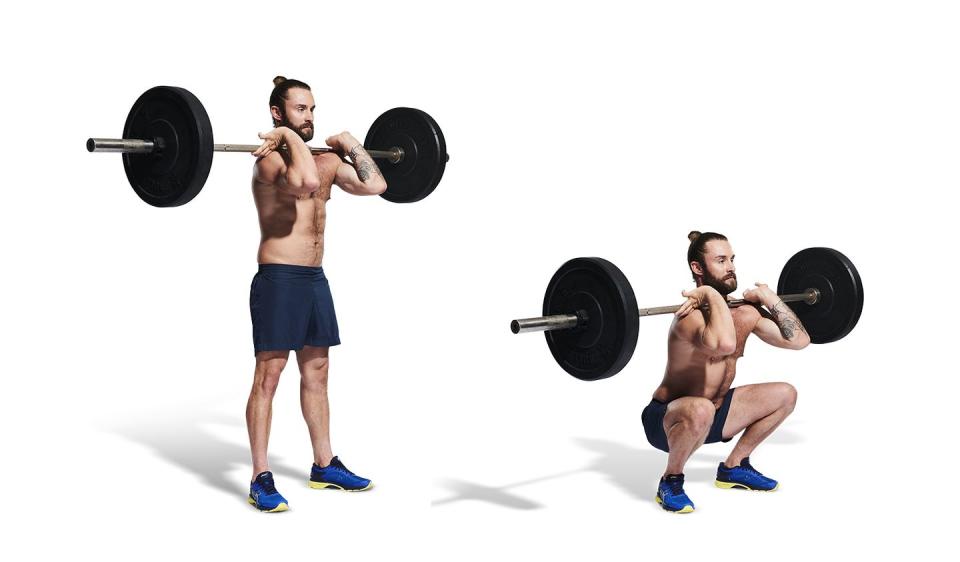
Front Squats
Why: Back squats get all the press, but by shifting the weight onto the front of our bodies (with either a bar or dumbbells), we can put a greater emphasis on the quadriceps. Switching from back to front is the quickest change you can make to your training to start seeing quad growth.
How: Stand with your feet shoulder-width apart holding a barbell across your upper chest. You can either support the weight on your fingers, with wrists extended, or cross your arms to support the weight. Taking care to not arch your back, push your hips back and bend your knees to lower your body until your thighs are parallel to the floor. Drive your heels into the floor to push yourself explosively back up to the start position.
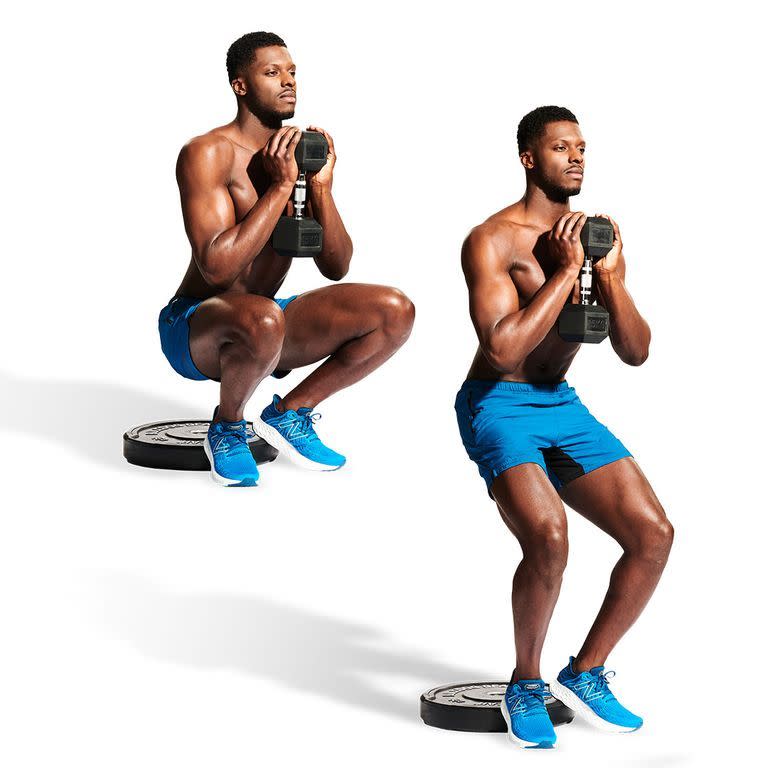
Heels Elevated Goblet Squats
Why: Elevating your heels during a squat is a shortcut to getting more range of motion, especially if you struggle with tight calf muscles. Heels elevated goblet squats, also known as cyclist squats, allow you to get DEEP, recruiting more muscle fibres in your quads and specifically targeting the vastus medialis, the 'tear drop' muscles on the inside of your thighs.
How: Stand tall on a large weight plate or block, around 3-4 inches tall, and make sure your heels are elevated with the balls of your feet on the floor. Grab a kettlebell and keeping your torso upright and feet close together, squat down until the crease of your hip passes below your knee, and your knees pass over your toes. Stand back up explosively and repeat.

Front Foot Elevated Split Squats
Why: By lifting one leg onto a bench or plate, not only do we open up a massive range of motion, but working one leg at a time means we require significantly less weight for the same effect. In fact, high rep sets of front foot elevated split squats often require just a light set of dumbbells, and can even be performed with just your body weight. You’ll also increase your stability and improve your knee health.
How: Stand tall on a large weight plate or block and hold dumbbells with straight arms by your sides. Keeping your chest up at all times, take a step backward with one leg, bending your front knee until the back knee touches the ground. Stand up explosively, pause and repeat with the other leg.

Seated Dumbbell Leg Extensions
Why: Isolating the muscles of the quads can be difficult without specific machinery, but by simply holding a dumbbell between your feet whilst siting on a box or a bench you’re able to work solely on ‘knee extension’, the primary function of the quadriceps. High rep sets are a great finisher after squats and lunges for maximum growth.
How: Sit on a box or bench, with your back straight and a dumbbell between your feet. With your knees at a 90 degree angle, extend your legs so that they're straight and parallel with the ground. Ensure that the rest of the body remains stationary. Pause for a second before slowly lowering the weight back to the original position, ensuring that you do not go past the 90-degree angle limit.

Sissy Squat
Why: A challenging bodyweight movement that builds powerful quads whilst building core strength and improving balance. This one takes some mastery, but requiring no kit it’s a movement that can easily be practiced at home. Work your way towards getting your knees all of the way to the ground, then back up again, under control and reap the benefits.
How: Stand with your feet shoulder-width apart, heels raised on a plate (or simply lift them from the floor) putting your weight through the balls of your feet. Place your hands on your hips or use a rack or wall to support you. Bend at the knees and lean backwards, creating a strong, rigid line from your knees to your head. Continue bending at the knees, maintaining your backwards lean, lowering your knees as close to the ground as possible before standing back up explosively. Repeat.

Banded Spanish Squats
Why: Spanish squats are a great low load alternative if you suffer from knee pain during heavy lifts. The band helps to keep you balanced whilst your shins remain vertical- this puts a huge emphasis on the quads, and is another good option for really isolating the quads in the absence of a leg extension machine.
How: Loop a resistance band around a rack, or set of heavy dumbbells. Step into the band so that it rests around the back of your knees. Take a few steps backwards until you feel strong tension on the band. With your feet in a narrow stance, push your hips back and drop into a deep squat, pause at the bottom before standing back up explosively against the resistance of the band. Repeat.
Front Foot Elevated Reverse Lunges
Why: Lunges are an excellent option for building all round leg mass. Just like split squats, by using one leg we’re able to half the amount of weight we need to use for the same stimulus, saving you on wear and tear through the rest of your body. By elevating your front foot with a plate or block, you’ll hugely increase the depth of your lunge. More range equals more muscle.
How: Stand on a small box, or stack of plates around three-to-four inches from the ground. Take a long step backwards with one foot until your toes make contact with the ground. Maintaining an upright torso bend at the front knee, slowly lowering until your back knee lightly touches the floor. Drive your weight through your front foot, standing back up explosively. Complete desired reps with one leg, before matching with the other side.
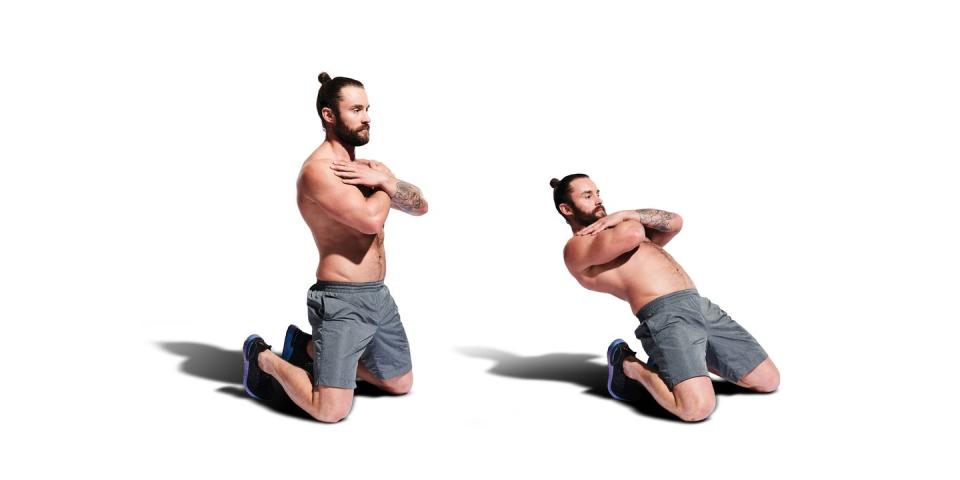
Goblet Squats
Why: Goblet squats are a super accessible quad burner that you can perform with just a single dumbbell or kettlebell. High rep efforts will help to build strength endurance in the quads, whilst super heavy sets will also help to build the postural muscles of your upper back, as well as your core.
How: Stand tall holding a kettlebell or dumbbell in the goblet position. Keep your torso upright as you push your hips back and bend at the knees, squatting down until the crease of your hip passes below your knee, and your knees pass over your toes. Stand back up explosively and repeat.

Lying Leg Extensions
Why: More accessible than the sissy squat, the lying leg extension builds strength through a huge range of motion, but also has enormous mobility benefits. Work on explosively bringing your torso upright but lowering back to the ground under a three-to-four second count.
How: Kneel on the ground, with your bum on your heels. Lean backwards and slowly lower your head towards the ground, use a rack to support your descent if necessary. When you feel a stretch through your quads, or begin to lose balance, explosively raise yourself back upright, ensuring you maintain a straight line from your knees to your head throughout. Repeat. Aim to progressively increase the depth you reach.
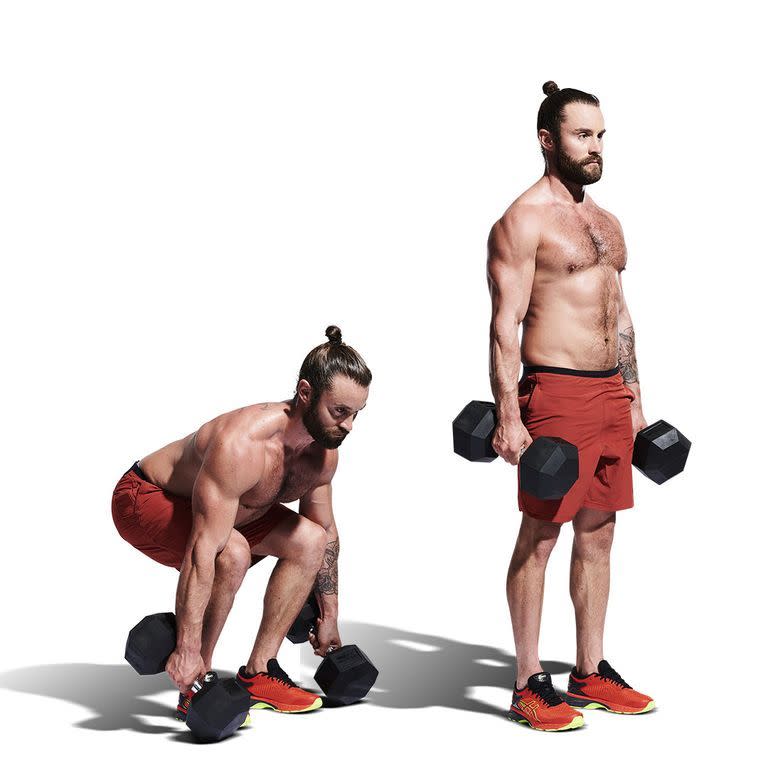
Dumbbell Deadlift
Why: Although predominantly an exercise that works your hamstrings, the dumbbell deadlift is still an effective moves that places great emphasis on your quads.
How: With your dumbbells on the floor just outside your feet, hinge down and grip them with a flat back and neutral spine. Engage your lats and stand upright, ‘pushing the ground away’ with your feet, squeezing your glutes at the top. Your arms should be hanging straight throughout this movement, think of them as hooks.
Top Tip: Lower the dumbbells down behind your body for an extreme quad bias.

Pistol Squats
Why: The ultimate test of your lower body strength and mobility. Squatting as low as possible, on one leg, whilst keeping the other leg stretched out in front of your body will challenge your core, hip flexors, balance and, of course, quadriceps. Start by learning to get up from a box or bench single legged, before progressing to performing reps supporting yourself on a rack, until you’re ready for the full challenge.
How: Stand with your feet in a narrow stance and lift one leg off the floor. Bend your standing knee to squat down as low as you can while keeping your back straight. Push back up to the start position through your heel, then switch legs and repeat. That's one rep.
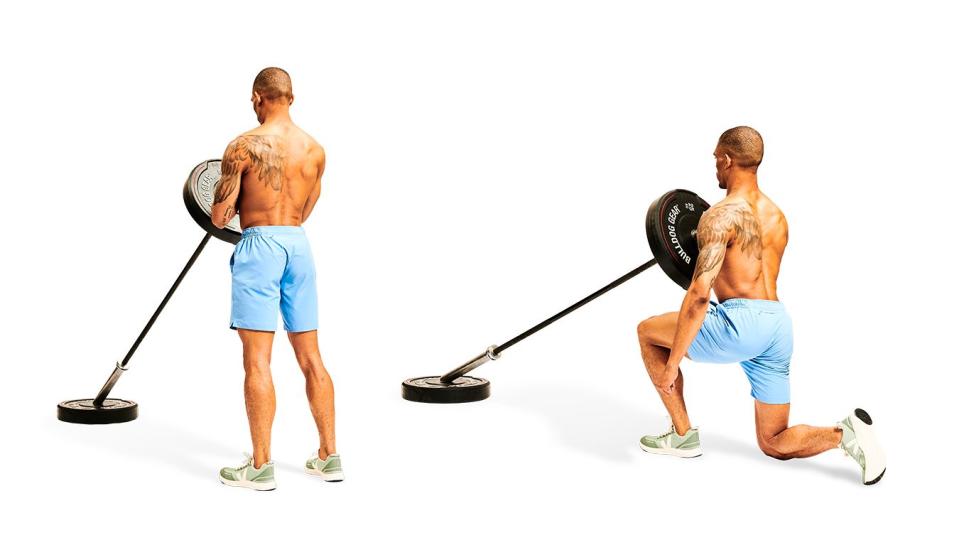
Landmine Lunge
Why: The front rack position of the landmine lunge places additional force through the front foot, targeting the quads and resulting in superior muscle building, without the queues for machines.
How: Stand upright holding the end of your barbell in a central position close to your chest with both hands. Step back with one leg, dropping back into a deep lunge position, before explosively standing upright. Finish your reps and complete on the other side.

Step-ups
Why: Step-ups not only deliver serious bang for their buck when it comes to building lower body muscle, they are also a unilateral (single limb) move. This means you'll be placing additional effort through the supporting leg, resulting in more resistance and therefore more muscle mass gained.
How: Stand in front of a box, with your feet hip-width apart, dumbbells at your sides. Step one foot up on top and drive your foot into the box. Lean forward slightly to keep your balance, but keep your torso upright. Once at the top, stand up fully by extending your knees and hips. Slowly step backward off the box and repeat with the opposite leg.
The Quad Dominant Workout
This workout utilises a ‘mechanical dropset’ working from the most difficult exercise, through to the least, raising the reps as you go, allowing you to push past the point of failure and fire up as many muscle fibres as possible in your quest for a set of enviable pins.
Work your way through five rounds of this triple pronged attack. Making sure to rest for two minutes between each round.

10 x Dumbbell/Kettlebell Front Squat
Clean a pair of moderate weight dumbbells or kettlebells up onto your shoulders and stand tall (A). From here, take a deep breath and drop into a front squat, until the crease of your hip passes below your knee (B), before driving back up. Lower yourself under control but ensure you’re standing back up explosively to get the most bang for your buck.
20 x Front Foot Elevated Reverse Lunge
Stand tall on a large weight plate or block, around 3-4 inches tall, hold your dumbbells with straight arms by your sides (A). Keeping your chest up at all times, take a step backward with one leg, bending your front knee until the back knee touches the ground (B). Stand up explosively, pause and repeat with the other leg.
30 x Heels Elevated Goblet Squats
Turn around onto the edge of your plate so that your heels are elevated with the balls of your feet on the floor. If necessary drop one or both of your dumbbells and continue with just your bodyweight (A) Keeping your torso upright and feet close together, squat down until the crease of your hip passes below your knee, and your knees pass over your toes (B) Stand back up explosively and repeat.
10 More Great Quad Workouts
If the workout above didn't tickle your fancy, choose from these 10 to give your upper legs a serious burn.
Set Your Quads and Hamstrings Ablaze With One Dumbbell Using This ‘21’s’ Workout
This Leg Day Ladder Pumps up Your Quads Using Nothing but Dumbbells
This Bodyweight Quad Burner Will Push Your Legs and Lungs For Full Body Gains At Home
Build Huge Quads (and The Hamstrings To Match) With Our Dumbbell Leg Day
Jason Momoa’s ‘Hybrid’ Leg Day Promises a Superhuman Quad Pump
Crush Your Legs in 15 Minutes with This Three-move Dumbbell Workou
Light up Your Lungs and Pump up Your Quads with This Leg-day Ladder
Two Dumbbells,15 Minutes and 115 Reps Are All You Need for Serious Leg Day Gains
You Might Also Like


